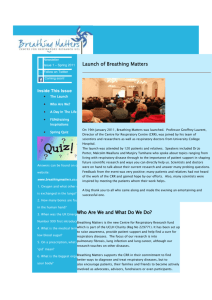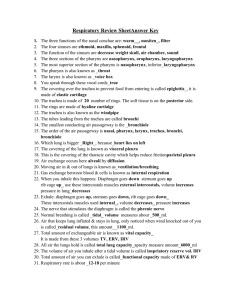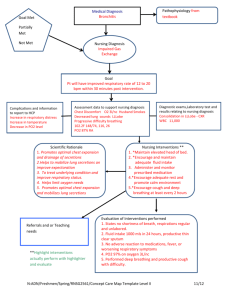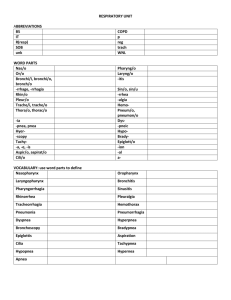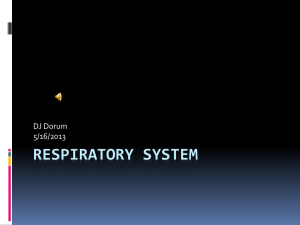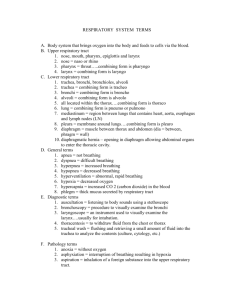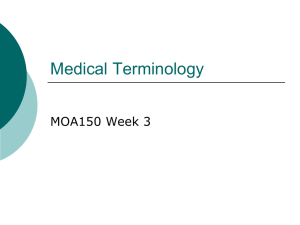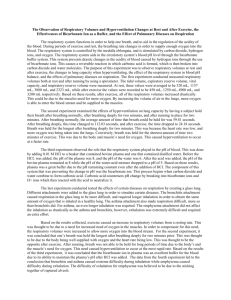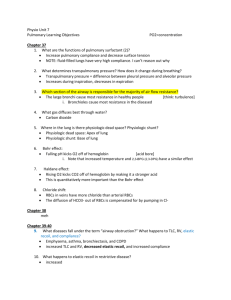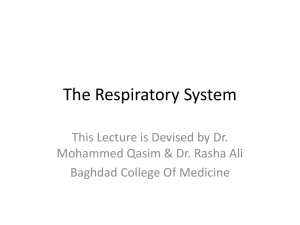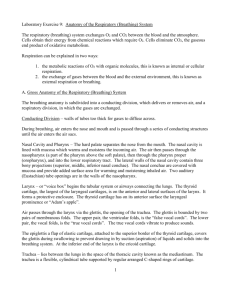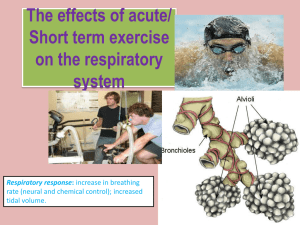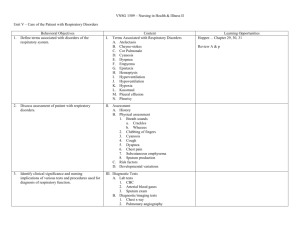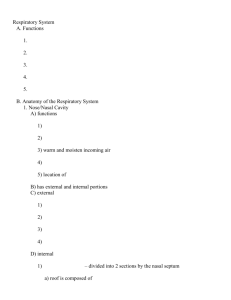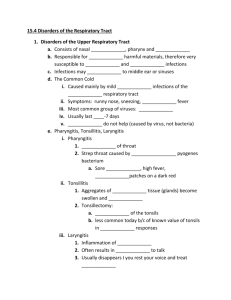Respiratory System, part 2 Notesheet Chronic Obstructive
advertisement
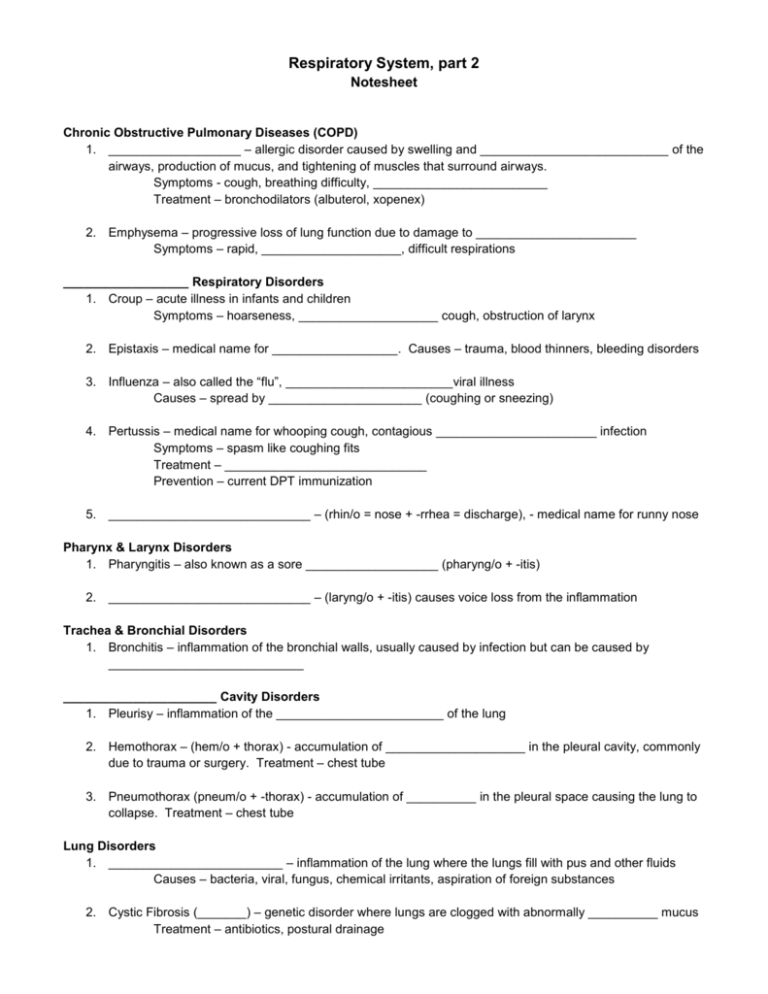
Respiratory System, part 2 Notesheet Chronic Obstructive Pulmonary Diseases (COPD) 1. ___________________ – allergic disorder caused by swelling and ___________________________ of the airways, production of mucus, and tightening of muscles that surround airways. Symptoms - cough, breathing difficulty, _________________________ Treatment – bronchodilators (albuterol, xopenex) 2. Emphysema – progressive loss of lung function due to damage to _______________________ Symptoms – rapid, ____________________, difficult respirations __________________ Respiratory Disorders 1. Croup – acute illness in infants and children Symptoms – hoarseness, ____________________ cough, obstruction of larynx 2. Epistaxis – medical name for __________________. Causes – trauma, blood thinners, bleeding disorders 3. Influenza – also called the “flu”, ________________________viral illness Causes – spread by ______________________ (coughing or sneezing) 4. Pertussis – medical name for whooping cough, contagious _______________________ infection Symptoms – spasm like coughing fits Treatment – _____________________________ Prevention – current DPT immunization 5. _____________________________ – (rhin/o = nose + -rrhea = discharge), - medical name for runny nose Pharynx & Larynx Disorders 1. Pharyngitis – also known as a sore ___________________ (pharyng/o + -itis) 2. _____________________________ – (laryng/o + -itis) causes voice loss from the inflammation Trachea & Bronchial Disorders 1. Bronchitis – inflammation of the bronchial walls, usually caused by infection but can be caused by ____________________________ ______________________ Cavity Disorders 1. Pleurisy – inflammation of the ________________________ of the lung 2. Hemothorax – (hem/o + thorax) - accumulation of ____________________ in the pleural cavity, commonly due to trauma or surgery. Treatment – chest tube 3. Pneumothorax (pneum/o + -thorax) - accumulation of __________ in the pleural space causing the lung to collapse. Treatment – chest tube Lung Disorders 1. _________________________ – inflammation of the lung where the lungs fill with pus and other fluids Causes – bacteria, viral, fungus, chemical irritants, aspiration of foreign substances 2. Cystic Fibrosis (_______) – genetic disorder where lungs are clogged with abnormally __________ mucus Treatment – antibiotics, postural drainage Breathing Disorders 1. ______________________________ (tachy- + -pnea) - more than 20 breaths per minute 2. Apnea – ________________________ of breathing 3. Dyspnea (dys/ + -pnea) – _________________________ or painful breathing 4. Hyperventilation – abnormally ___________________, deep breathing Lack of Oxygen 1. Airway obstruction – food or foreign object _________________________ the airway and prevents air from entering or leaving the lungs. Treatment – Heimlich maneuver 2. _________________________ (cyan- + -osis) – bluish color of skin caused by lack of oxygen 3. Respiratory Failure – level of oxygen in blood is dangerously __________ or the carbon dioxide is dangerously __________________ ____________________________ Procedures 1. Respiratory Rate (RR) – counted number of respirations per minute; part of the vital signs; normal is _______ to ________ /min for adults 2. Pulmonary function tests – _______________________ of tests that measure lung capacity 3. Chest __________________ – useful to show pneumonia, tumors, TB, pneumothorax Treatments/Procedures of Respiratory System 1. Septoplasty (sept/o + -plasty) – _______________________________ of the nasal septum 2. Laryngectomy (laryng/o + -ectomy) surgical ______________________ of the larynx 3. ________________________ intubation – passage of a tube through the nose or mouth into the trachea, used to assist breathing 4. Tracheostomy (trache/o + -ostomy) surgical creation of a _______ ___________________ in the trachea 5. Lobectomy – surgical _____________________ of a lobe of the lung 6. _____________________________ (thorac/o + -otomy) - surgical incision of the thorax Respiratory Therapy 1. Supplemental oxygen – used to provide _______________ oxygen to the patient; nasal cannula or mask may be used 2. Ventilator – mechanical device used to supplement or ______________________ the patients breathing function (while in surgery, with spine injury, etc…) Career Opportunities 1. Respiratory ______________________ (RT) – provides oxygen, gases or medications under a Drs. order 2. Respiratory Therapy ____________________________ – works under the supervision of the RT
